Parametric Study of the Effects of a Vortex Generator on the Combustion Characteristics of Liquid Petroleum Gas and Physical Air–Fuel Flow on a Slot Burner
Abstract
1. Introduction
2. Methodology
2.1. Combustion Equation
2.2. Equivalent Ratio
2.3. Slot Burner Model
2.4. Combustion Model Analysis
2.5. Temperature Distribution Analysis
2.6. Velocity Streamline Analysis
3. Results and Discussion
3.1. Validation of the PBSB Model
Velocity Profile on the PBSB
3.2. Combustion Analysis of the Porous Vortex Generator Slot Burner (PVGSB) Model
3.2.1. Velocity Profile of the PVGSB
3.2.2. Temperature Distribution on the PVGSB
3.3. Combustion Analysis of the Vortex Generator Slot Burner (VGSB) Model
3.3.1. Velocity Profile on the VGSB
3.3.2. Temperature Distribution in the VGSB
4. Conclusions
Author Contributions
Funding
Data Availability Statement
Acknowledgments
Conflicts of Interest
Nomenclature
| Abbreviations | |
| AR | Aspect ratio [-] |
| Constant value of two for the intermittency equation [-] | |
| Constant value of 0.006 for the intermittency equation [-] | |
| Constant value of one for the energy equation [-] | |
| Constant value of 50 for the energy equation [-] | |
| , [N/m3] | |
| Empirical correlation for length of the transition region [-] | |
| H | Enthalpy [kJ/mol] |
| Diffusion flux of species j [kg/m2 s] | |
| Effective thermal conductivity [W/m K] | |
| Turbulent thermal conductivity [W/m K] | |
| P | Static pressure [bar] |
| S | Distance between VGs [mm] |
| Heat of chemical reaction [kJ/mol] | |
| Sm | Mass added on continuous phase [kg] |
| Symbols | |
| Dynamic viscosity [N. s/m2] | |
| Φ | Equivalence ratio [-] |
| Intermittency | |
| τ̿ | Stress tensor [N/m2] |
| Vorticity magnitude [Hz] | |
| θ | Vortex generator angle [°] |
References
- Energy Policy and Planning Office, Energy Overview. Available online: https://anyflip.com/qivjx/nvxn/ (accessed on 1 January 2024).
- PTT, Knowledge and Safety with Cooking Gas. Available online: http://www.gastechelectronics.com (accessed on 1 September 2023).
- Office of Energy Policy and Planning, LPG. Available online: https://www.eppo.go.th/images/Infromation_service/Publication/Knowledge/LPG%20fuel.pdf (accessed on 25 December 2023).
- Department of Alternative Energy Development and Efficiency, Ministry of Energy, Training Textbook for Persons Responsible for Thermal Energy, Part 2, Chapter 3, Theory of Combustion. Available online: http://www2.dede.go.th/bhrd/old/file_handbook.html (accessed on 7 September 2023).
- Engineering Toolbox, Gas Density. Available online: https://www.engineeringtoolbox.com/gas-density-d_158.html (accessed on 7 September 2023).
- Ministry of Energy, Regulations and Methods of Storage, Assignment of Responsible Special Personel, and Exemption to Follow the Hazardous Substances Act 1992 (B.E.2535) for Areas of Liquefied Petroleum Gas Responsible by the Department of Energy Business. Available online: http://elaw.doeb.go.th/document_doeb/EN/347_0001.pdf (accessed on 15 May 2024).
- Jugjai, S. Combustion; Chulalongkorn University Press: Bangkok, Thailand, 2004; pp. 49–55, 91–95, 206–207, 234–235, 575–577. [Google Scholar]
- Kwok, L.C.; Leung, C.W.; Cheung, C.S. Heat Transfer Characteristics of Slot and Round Premixed Impinging Flame Jets. Exp. Heat Transf. 2003, 16, 111–137. [Google Scholar] [CrossRef]
- U.S. Centennial of Flight Commission, 1991, Aerodynamic Resistance and the Use of Aerodynamic Coefficients. Available online: https://www.centennialofflight.net/essay/Theories_of_Flight/TH-OV.htm (accessed on 15 May 2024).
- Patel, V.; Shah, R. Experimental investigation on flame appearance and emission characteristics of LPG inverse diffusion flame with swirl. Appl. Therm. Eng. 2018, 137, 377–385. [Google Scholar] [CrossRef]
- Caliskan, S. Experimental investigation of heat transfer in a channel with new winglet-type vortex generators. Int. J. Heat Mass Transf. 2014, 78, 604–614. [Google Scholar] [CrossRef]
- Zheng, Y.; Yang, H.; Mazaheri, H.; Aghaei, A.; Mokhtari, N.; Afrand, M. An investigation on the influence of the shape of the vortex generator on fluid flow and turbulent heat transfer of hybrid nanofluid in a channel. J. Therm. Anal. Calorim. 2021, 143, 1425–1438. [Google Scholar] [CrossRef]
- Ke, Z.; Chen, C.L.; Li, K.; Wang, S.; Chen, C.H. Vortex dynamics and heat transfer of longitudinal vortex generators in a rectangular channel. Int. J. Heat Mass Transf. 2018, 132, 871–885. [Google Scholar] [CrossRef]
- Promthaisong, P.; Promvonge, P.; Khanoknaiyakarn, C.; Skullong, S. Numerical Heat Transfer Investigation in a Solar Receiver Heat Exchanger Channel with Punched Elliptical-Winglet Vortex Generators. Eng. J. 2021, 25, 105–114. [Google Scholar] [CrossRef]
- Raykowski, K.A. Optimization of a Vortex Generator Configuration for a 1/4-Scale Piper Cherokee Wing; Embry-Riddle Aeronautical University: Daytona Beach, FL, USA, 1999; p. 24. [Google Scholar]
- Du, X.; Feng, L.; Li, L.; Yang, L.; Yang, Y. An investigation on the influence of the shape of the vortex generator on fluid flow and turbulent heat transfer of hybrid nanofluid in a channel. Int. J. Heat Mass Transf. 2014, 75, 368–380. [Google Scholar] [CrossRef]
- Fouatih, O.M.; Medale, M.; Imine, O.; Imine, B. Design optimization of the aerodynamic passive flow control on NACA 4415 airfoil using vortex generators. Eur. J. Mech. B/Fluids 2016, 56, 82–96. [Google Scholar] [CrossRef]
- Olfian, H.; Zabihi Sheshpoli, A.; Mousavi Ajarostaghi, S.S. Numerical evaluation of the thermal performance of a solar air heater equipped with two different types of baffles. Heat Transf. 2020, 49, 1149–1169. [Google Scholar] [CrossRef]
- PTT, Factors that Make the Combustion Complete. Available online: https://dscng.pttplc.com (accessed on 8 September 2023).
- Hamdi, M.; Rouaud, O.; Tarlet, D.; Havet, M. Experimental investigation on convective heat transfer enhancement by EHD in wire to plate configuration. Therm. Sci. Eng. Prog. 2021, 26, 101086. [Google Scholar] [CrossRef]
- Mahesh, S.; Mishra, D.P. Flame stability and emission characteristics of turbulent LPG IDF in a backstep burner. Fuel 2008, 87, 2614–2619. [Google Scholar] [CrossRef]
- Mahesh, S.; Mishra, D.P. Flame structure of LPG-air Inverse Diffusion Flame in a backstep burner. Fuel 2010, 89, 2145–2148. [Google Scholar] [CrossRef]
- Rabee, B.A. The Effect of Inverse Diffusion Flame Burner-Diameter on Flame Characteristics and Emissions. Energy 2018, 160, 1201–1207. [Google Scholar] [CrossRef]
- Bagheri, G.; Hosseini, S.E.; Wahid, M.A. Effects of bluff body shape on the flame stability in premixed micro-combustion of hydrogen-air mixture. Appl. Therm. Eng. 2014, 67, 266–272. [Google Scholar] [CrossRef]
- Sudjan, T.; Jugjai, S.; Kaewpradap, A. Combustion Characteristics of C3H8/C4H10 Flames affected by Air Flow Bluff Body on Non-Premixed Slot Burner. Suranaree J. Sci. Technol. 2021, 28, 010044. [Google Scholar]
- Strehlow, R.A. Combustion Fundamentals, McGraw-Hill Series in Energy, Combustion and Environment; McGraw-Hill College: New York, NY, USA, 1985; p. 27. ISBN 0-07-Y66599-0. [Google Scholar]
- Ansys Innovation Courses. Available online: https://innovationspace.ansys.com/courses/wp-content/uploads/2020/06/Governing-Equations-of-Fluid-Dynamics-Lesson4-Conservation-of-Momentum-Handout.pdf (accessed on 25 January 2024).

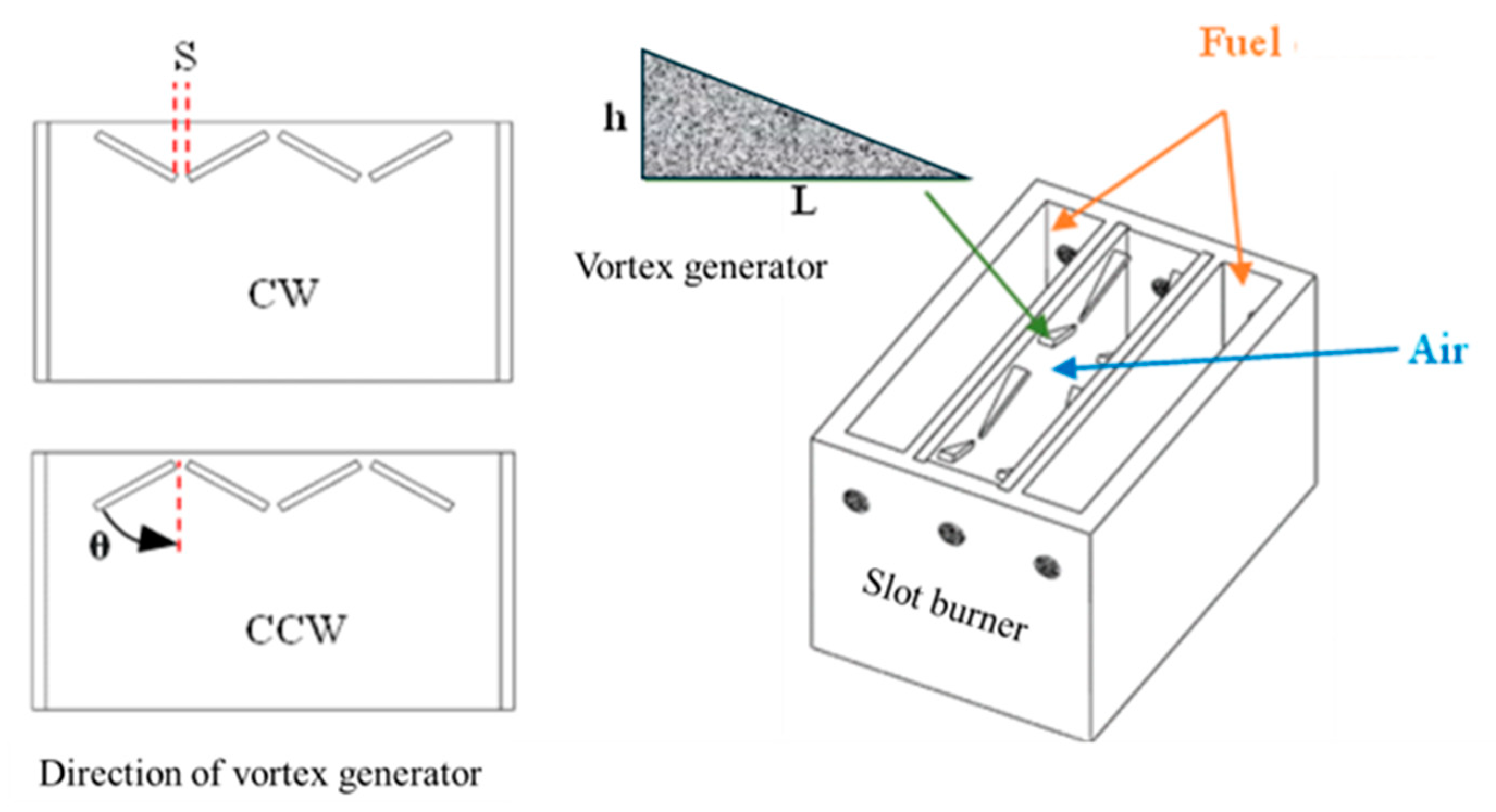

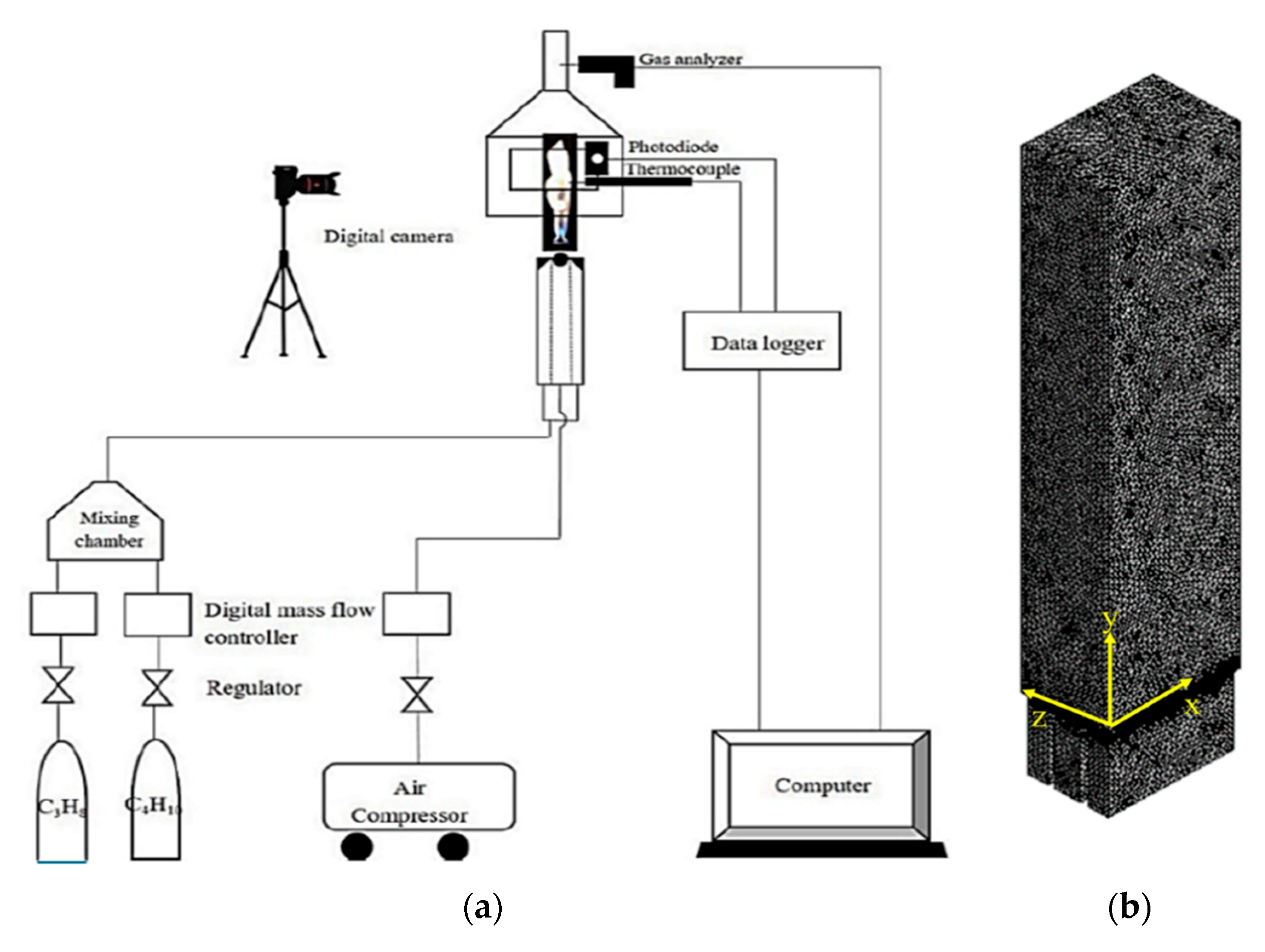
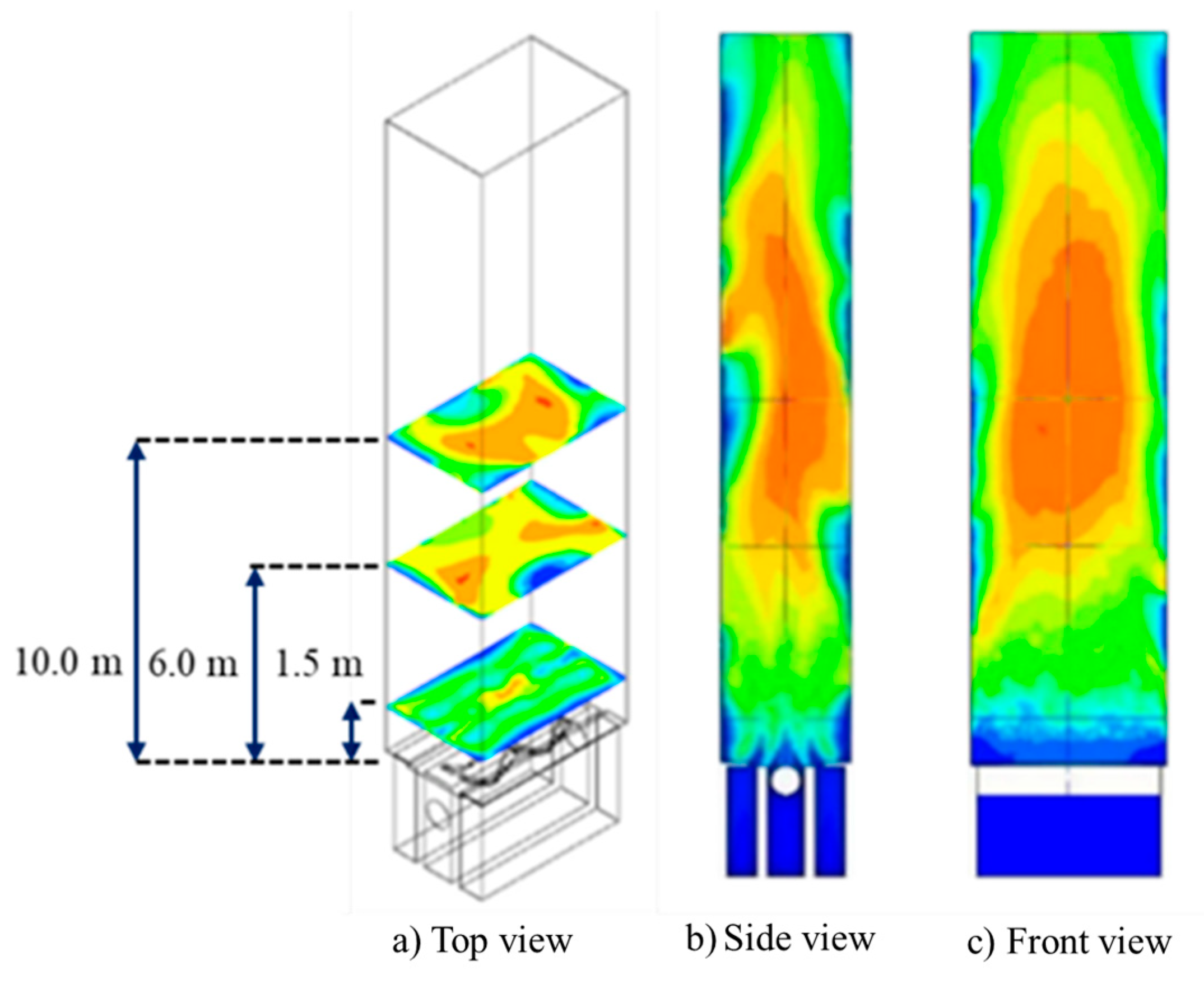
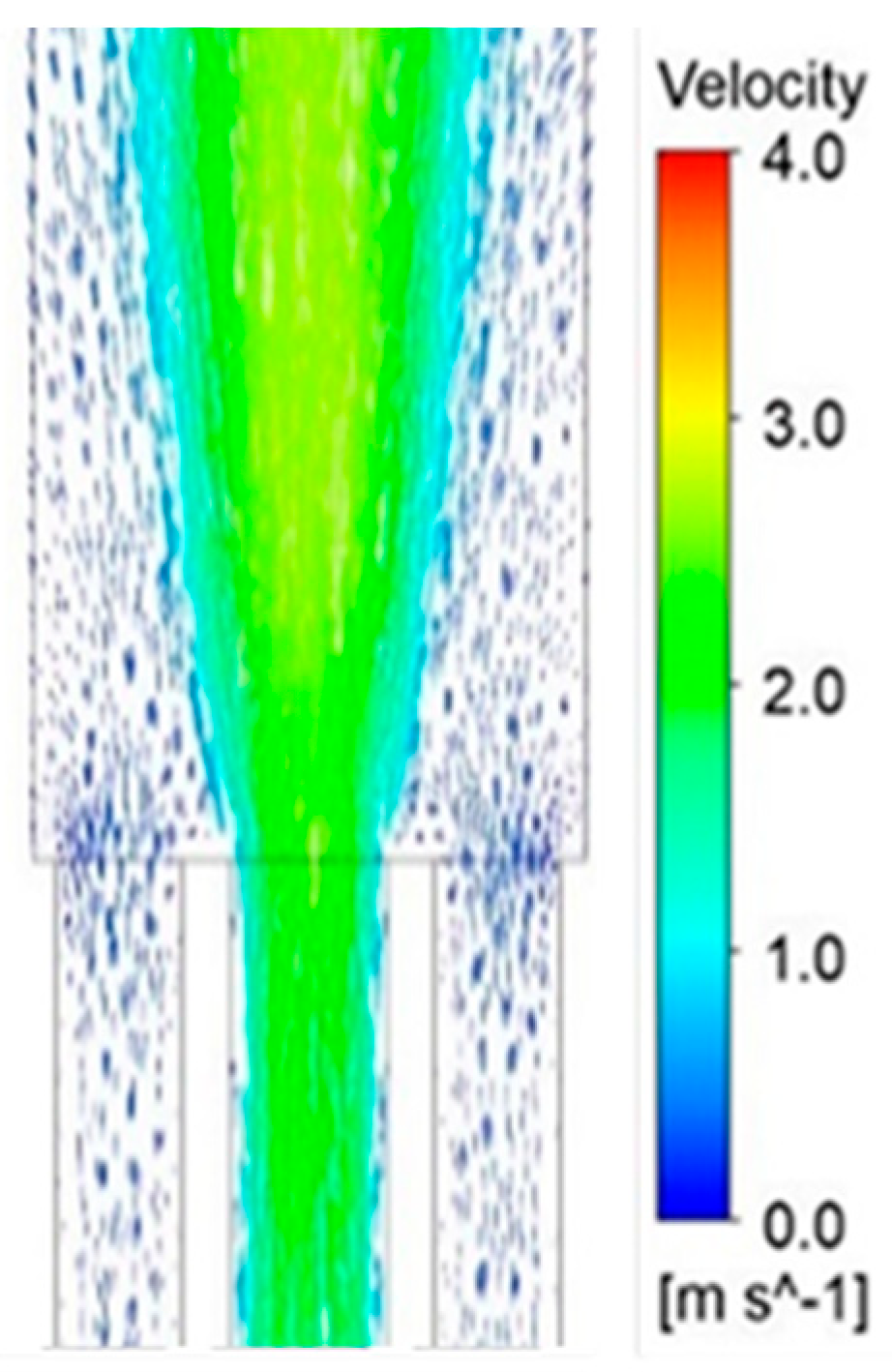

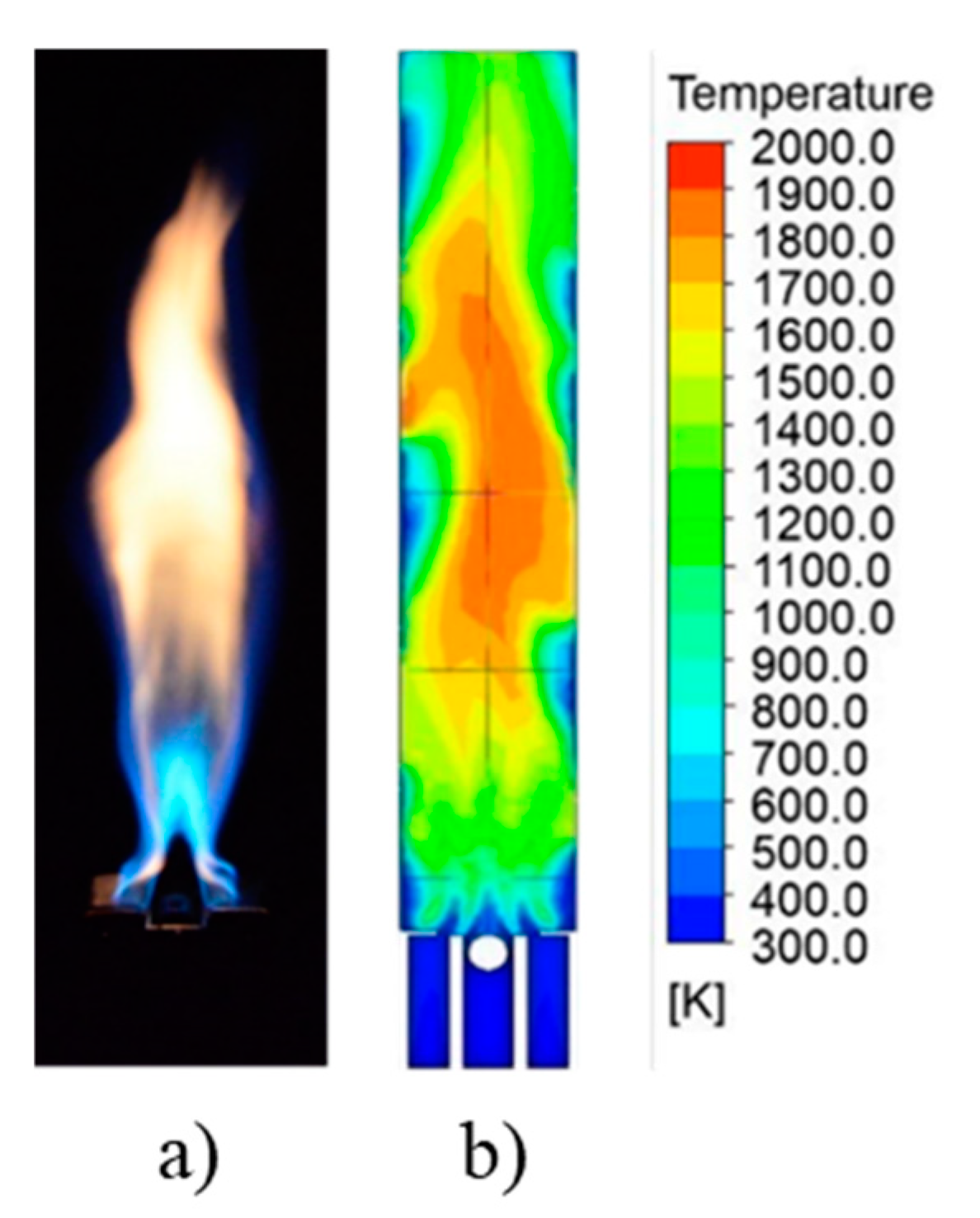

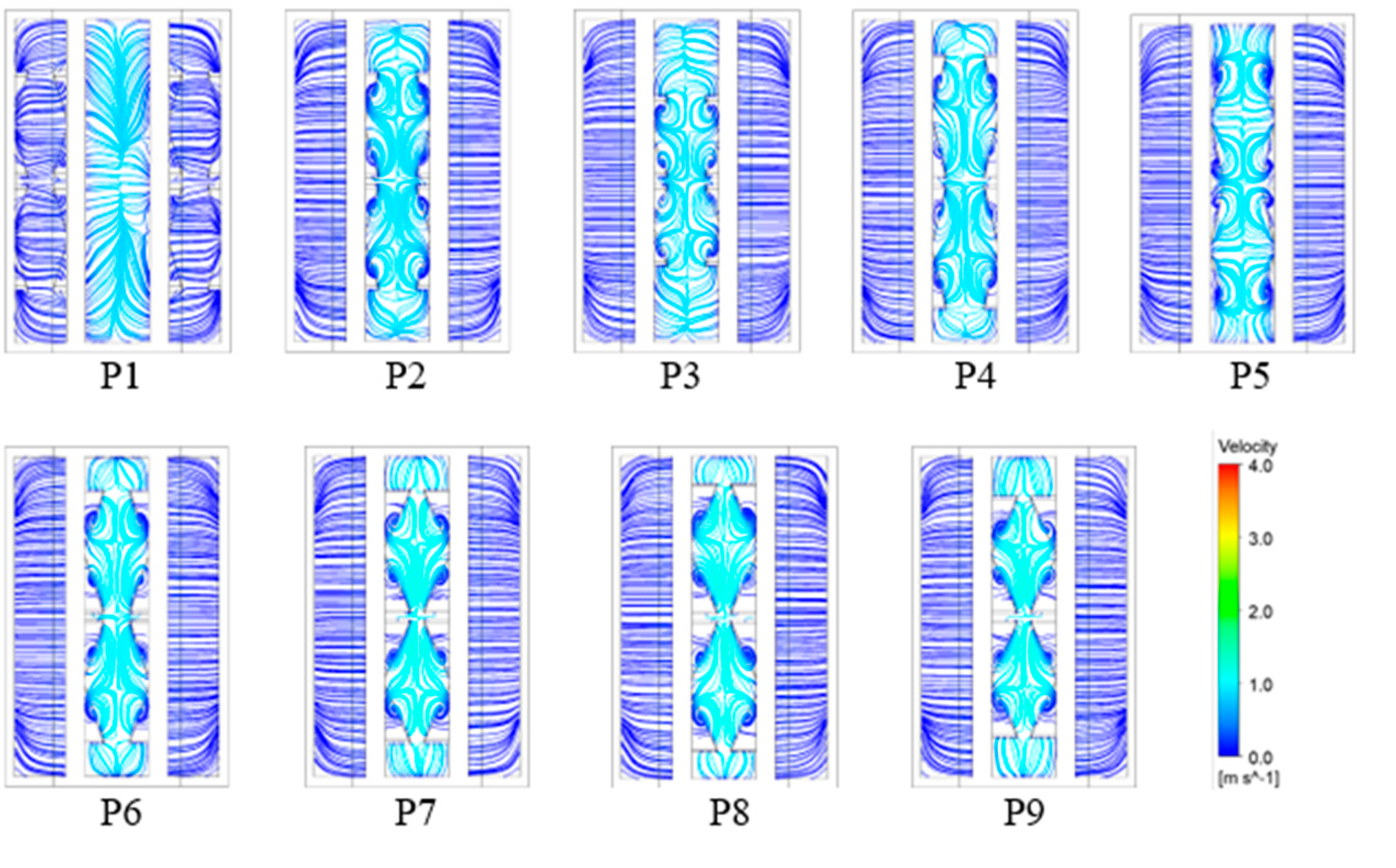

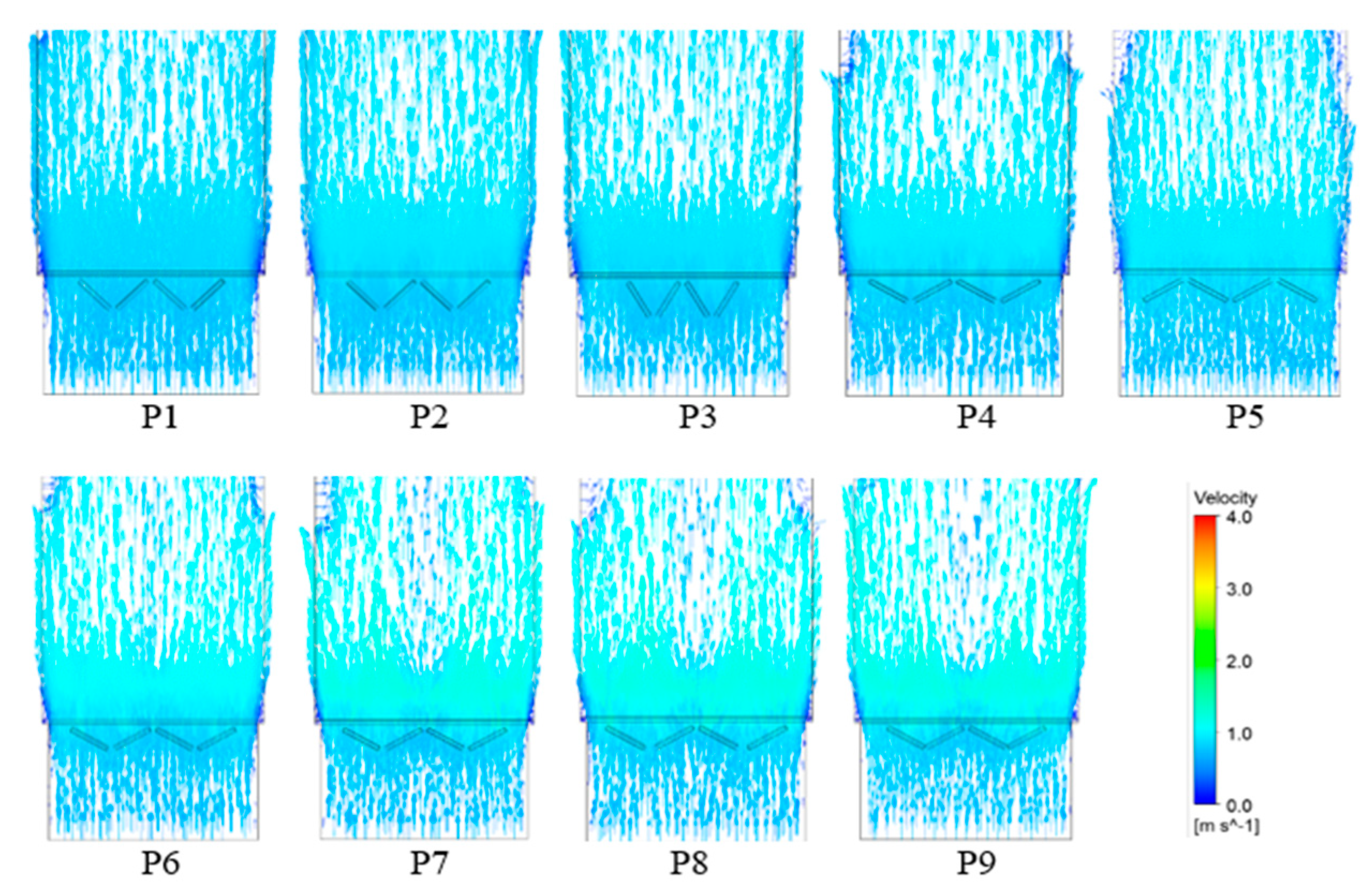


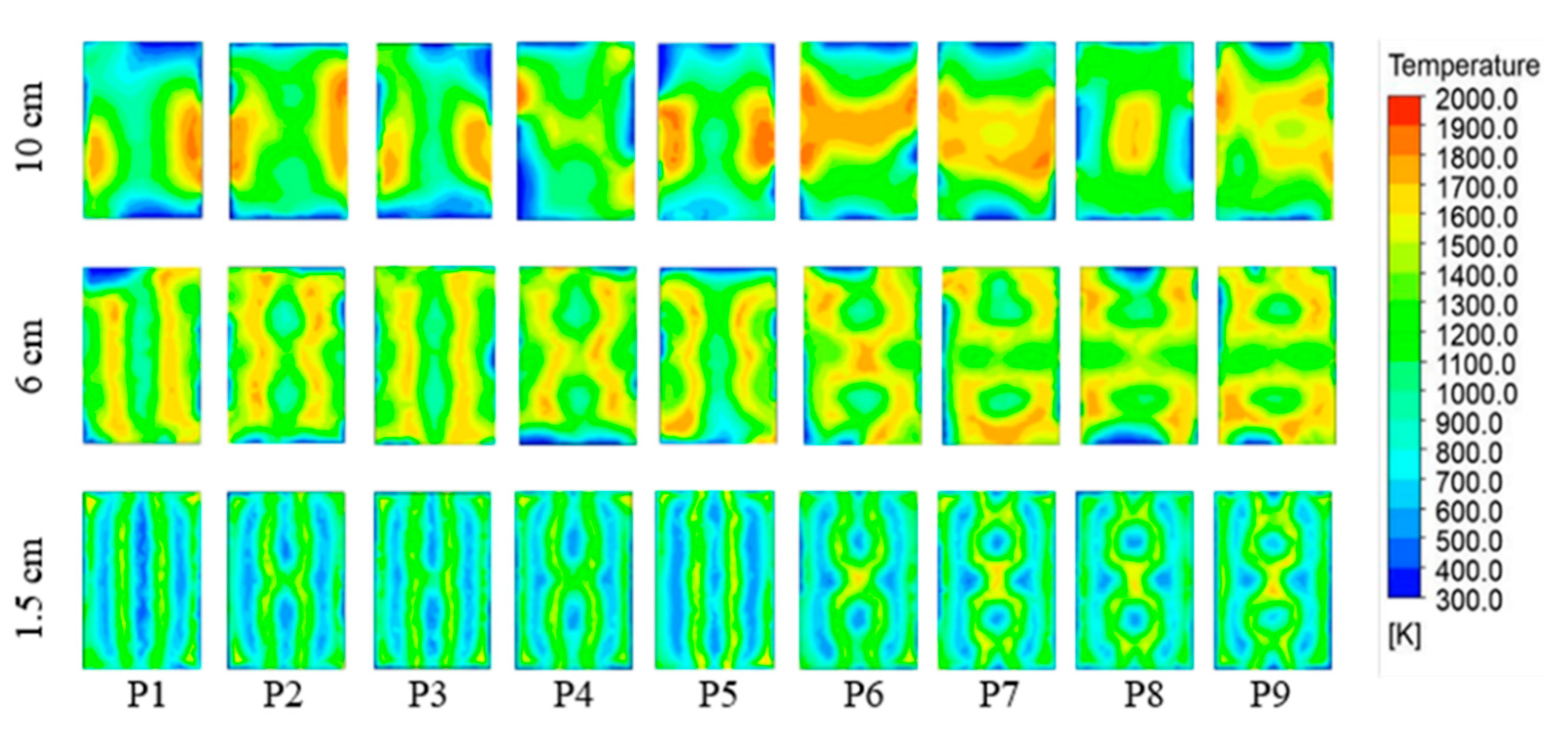
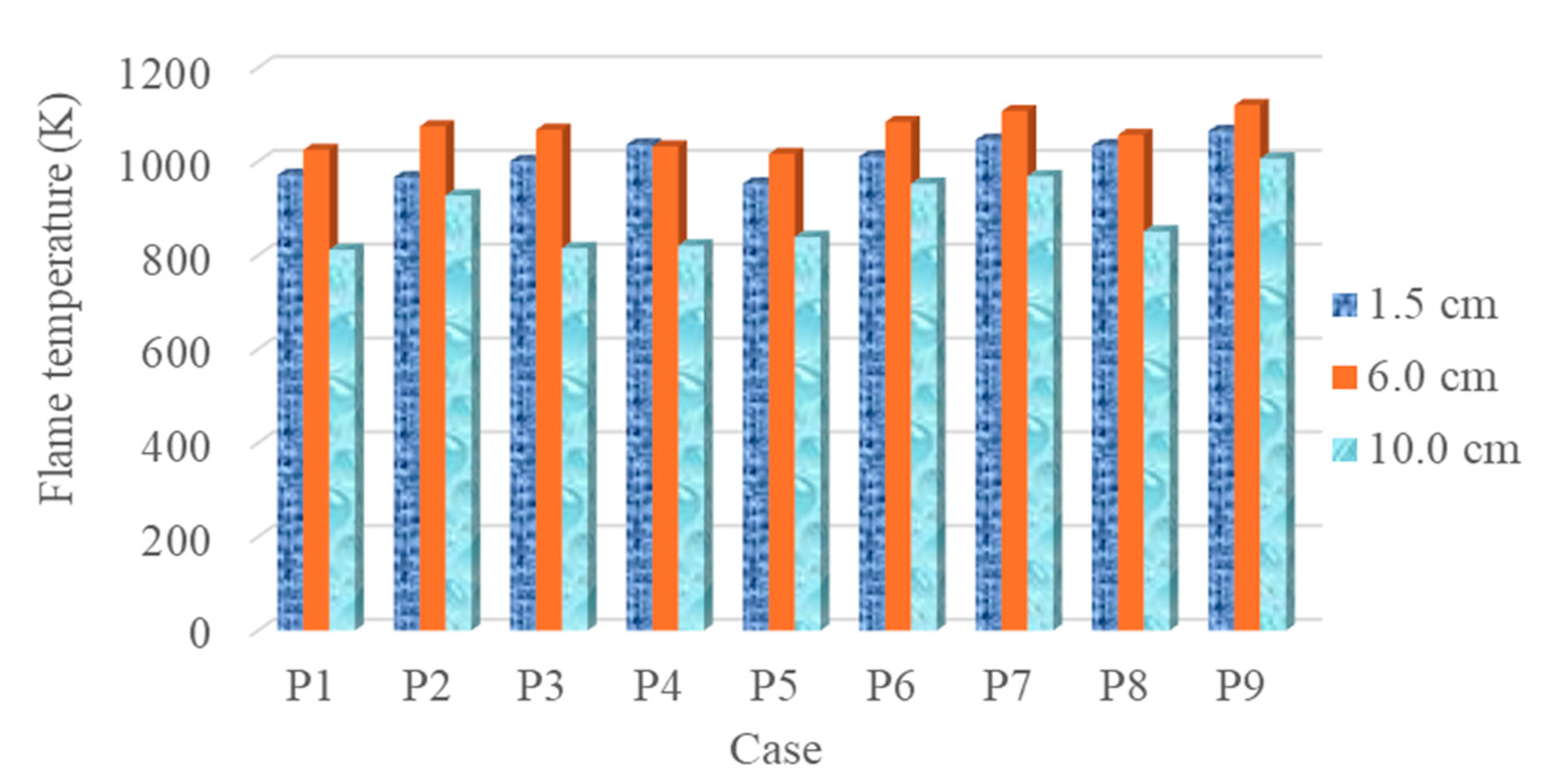




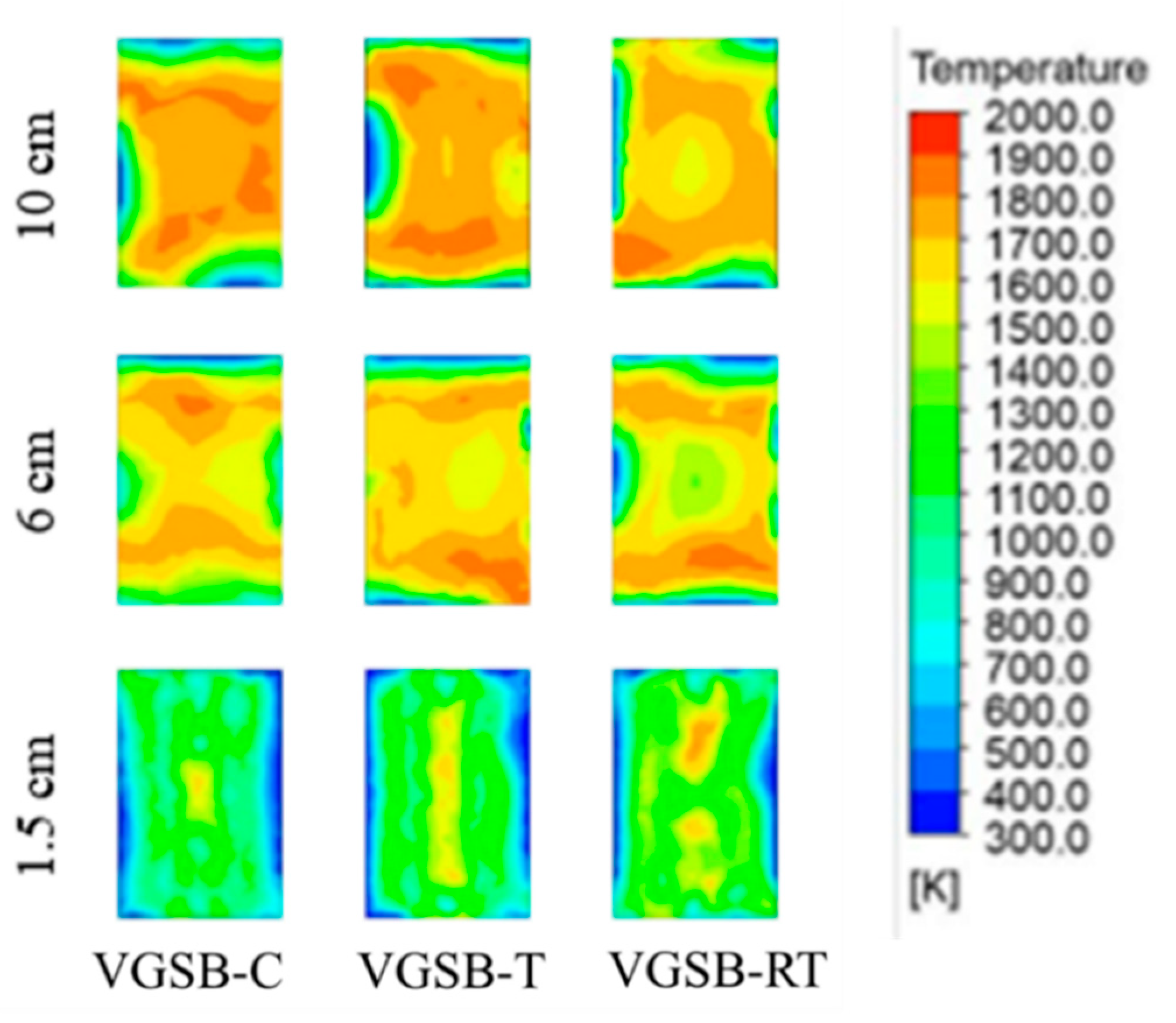

| Case | Position | Angle (θ) | Direction | Aspect Ratio | Distance | ||||||||
|---|---|---|---|---|---|---|---|---|---|---|---|---|---|
| F | A | 30° | 45° | 60° | CW | CCW | 0.2 | 0.3 | 0.4 | 0 | 1 | 2 | |
| P1 | ● | ● | ● | ● | ● | ||||||||
| P2 | ● | ● | ● | ● | ● | ||||||||
| P3 | ● | ● | ● | ● | ● | ||||||||
| P4 | ● | ● | ● | ● | ● | ||||||||
| P5 | ● | ● | ● | ● | ● | ||||||||
| P6 | ● | ● | ● | ● | ● | ||||||||
| P7 | ● | ● | ● | ● | ● | ||||||||
| P8 | ● | ● | ● | ● | ● | ||||||||
| P9 | ● | ● | ● | ● | ● | ||||||||
| Case | Position | Angle | Direction | Aspect Ratio | Distance | Bluff-Body Shape |
|---|---|---|---|---|---|---|
| A | 60° | CW | 0.4 | 0 mm | ||
| VGSB-C | ● | ● | ● | ● | ● | Cylinder |
| VGSB-T | ● | ● | ● | ● | ● | Triangle |
| VGSB-RT | ● | ● | ● | ● | ● | Reverse triangle |
| Boundary Condition at the Burner Inlet | Unit | Value |
|---|---|---|
| C3H8 | [%] | 0.7 |
| C4H10 | [%] | 0.3 |
| Airflow rate | [L/min] | 20 |
| Air pressure | [Pa] | 202,650 |
| Fuel pressure | [Pa] | 101,325 |
| Fuel inlet velocity | [m/s] | 0.0537 |
| Mesh | [elements] | 200,000–500,000 |
| Emissivity | [-] | 0.44 |
| Heat transfer coefficient | [W/m2·K] | 400 |
Disclaimer/Publisher’s Note: The statements, opinions and data contained in all publications are solely those of the individual author(s) and contributor(s) and not of MDPI and/or the editor(s). MDPI and/or the editor(s) disclaim responsibility for any injury to people or property resulting from any ideas, methods, instructions or products referred to in the content. |
© 2024 by the authors. Licensee MDPI, Basel, Switzerland. This article is an open access article distributed under the terms and conditions of the Creative Commons Attribution (CC BY) license (https://creativecommons.org/licenses/by/4.0/).
Share and Cite
Kaewpradap, A.; Phoothornsri, M. Parametric Study of the Effects of a Vortex Generator on the Combustion Characteristics of Liquid Petroleum Gas and Physical Air–Fuel Flow on a Slot Burner. Energies 2024, 17, 4608. https://doi.org/10.3390/en17184608
Kaewpradap A, Phoothornsri M. Parametric Study of the Effects of a Vortex Generator on the Combustion Characteristics of Liquid Petroleum Gas and Physical Air–Fuel Flow on a Slot Burner. Energies. 2024; 17(18):4608. https://doi.org/10.3390/en17184608
Chicago/Turabian StyleKaewpradap, Amornrat, and Maneeratanaporn Phoothornsri. 2024. "Parametric Study of the Effects of a Vortex Generator on the Combustion Characteristics of Liquid Petroleum Gas and Physical Air–Fuel Flow on a Slot Burner" Energies 17, no. 18: 4608. https://doi.org/10.3390/en17184608
APA StyleKaewpradap, A., & Phoothornsri, M. (2024). Parametric Study of the Effects of a Vortex Generator on the Combustion Characteristics of Liquid Petroleum Gas and Physical Air–Fuel Flow on a Slot Burner. Energies, 17(18), 4608. https://doi.org/10.3390/en17184608







